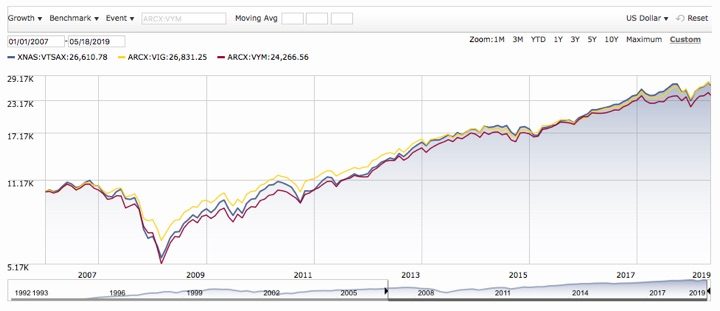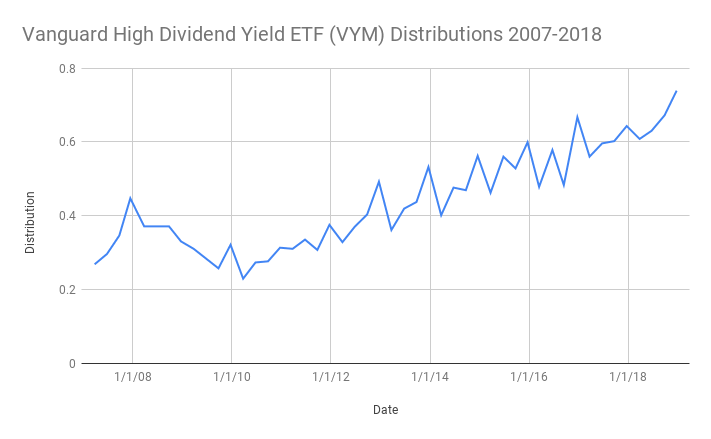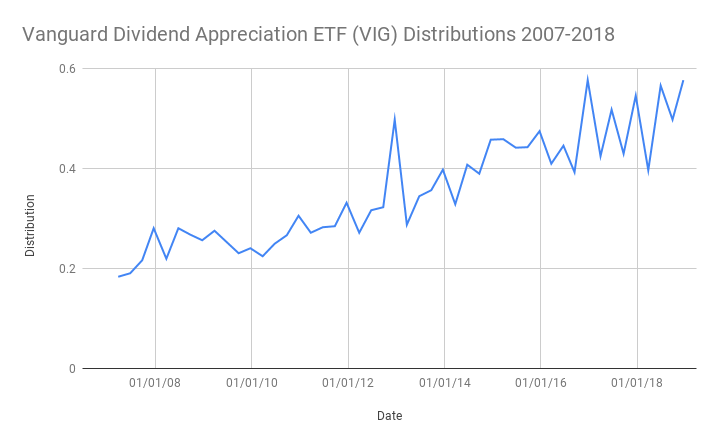 After my post on mailbox money last week, I did some poking around comparing different dividend-focused ETFs. Specifically, the idea of focusing on companies with a steadily growing dividend, not a high dividend yield. Here are three different ways that you could buy an ETF and live off the dividends:
After my post on mailbox money last week, I did some poking around comparing different dividend-focused ETFs. Specifically, the idea of focusing on companies with a steadily growing dividend, not a high dividend yield. Here are three different ways that you could buy an ETF and live off the dividends:
- Vanguard Total Market ETF (VTI). The CRSP US Total Market Index includes ALL of the US companies in proportion to their size (market cap). SEC yield was 1.83% as of 4/30/19.
- Vanguard High Dividend Yield ETF (VYM). The FTSE High Dividend Yield Index screens for companies with high dividend yields. SEC yield was 3.25% as of 4/30/19.
- Vanguard Dividend Appreciation ETF (VIG). The NASDAQ US Dividend Achievers Select Index screens for companies with at least ten consecutive years of increasing annual regular dividend payments. SEC yield was 1.86% as of 4/30/19.
We see that buying the high-dividend ETF would definitely get you bigger quarterly dividends upfront. But what about total return (share price appreciation + reinvested dividends)? We don’t know the future, but let’s see how things worked out through the Great Recession. Both of the dividend ETFs started in 2006, so here is what would have happened to $10,000 invested in each of the ETFs as of January 1st, 2007. I used Morningstar charts for this.

Here are two main takeaways:
- At the depths of the crash in early 2008, the high-dividend ETF (VYM) suffered the worst drawdown, while the steady dividend ETF (VIG) had the mildest drawdown. Your $10,000 would have gone down to $5,175 with VYM, $5,564 with VTI/VTSAX, and $6,400 with VIG.
- The total return numbers are relatively similar over the long run. Right now, the steady dividend ETF (VIG) is even leading slightly. As of 5/18/2019, your final values for the $10,000 invested in 1/1/2007 are $24,267 with VYM, $26,610 with VTI/VTSAX, and $26,831 with VIG.
What about consistency of dividends? One of the difficult things about retirement investing is that while the price of things can vary, most people like the idea of a steady income. We can look back and see if the steady dividend ETF really delivered even through the 2008 Great Recession. Here’s are the quarterly dividends from 2007 to 2018 for both the Vanguard High Dividend Yield ETF (VYM) and Vanguard Dividend Appreciation ETF (VIG):


The Vanguard Dividend Appreciation ETF (VIG) did provide a much more steady “paycheck” through 2008 and 2009 than the Vanguard High Dividend Yield ETF (VYM). If you relied on this money to pay your monthly bills, a steady dividend that didn’t drop with the overall stock market would be greatly appreciated.
Bottom line. Simply buying stocks with high dividends is not the solution to all your problems, as that high dividend may drop significantly during a bear market. In this historical comparison, the steady dividend method worked out pretty well. Since 2007, you got a lower drawdown during the bear market, solid long-term returns, AND a steady dividend check throughout. The future may not turn out the same way, but it’s definitely something to research further. One might even accept a little bit less total return for a more reliable stream of income.
Disclosures: I own VTI, aka the entire haystack. I don’t own VIG or VYM.
 The Best Credit Card Bonus Offers – October 2024
The Best Credit Card Bonus Offers – October 2024 Big List of Free Stocks from Brokerage Apps
Big List of Free Stocks from Brokerage Apps Best Interest Rates on Cash - October 2024
Best Interest Rates on Cash - October 2024 Free Credit Scores x 3 + Free Credit Monitoring
Free Credit Scores x 3 + Free Credit Monitoring Best No Fee 0% APR Balance Transfer Offers
Best No Fee 0% APR Balance Transfer Offers Little-Known Cellular Data Plans That Can Save Big Money
Little-Known Cellular Data Plans That Can Save Big Money How To Haggle Your Cable or Direct TV Bill
How To Haggle Your Cable or Direct TV Bill Big List of Free Consumer Data Reports (Credit, Rent, Work)
Big List of Free Consumer Data Reports (Credit, Rent, Work)
How do you feel about REIT funds? I consider them separate than regular dividend stocks since they are property and not traditional companies. They have higher yield, but I hold them in lieu of actual property holdings. I consider dividend stocks separate.
I like REIT funds and own them as small part of my portfolio, but the dividends are taxed at a higher rate so I keep them in IRA/401ks. I don’t know about how steady those distributions are during a recession, however.
https://www.mymoneyblog.com/portfolio-income-march-2019-q1.html
Jonathan, once again, great articles on topics of interest to me. My wife and I are maybe 5 years from an early ‘semi-retirement’. I like the idea of letting the dividends reinvest and compound until I need them. Is there a ballpark % of assets you think should be devoted to a dividend strategy?
Thanks! I don’t really have a ballpark. I think the overall stock/bond mix is still important. I guess right now I view myself as on (semi)retirement training wheels. I have the income (dividends + interest) coming in from our portfolio, which right now covers our expenses. However, we still have some income so I don’t have the full “fear factor” if things so badly and that portfolio income drops. It would be nice if I was more confident that the dividends would stay constant through the next recession, but I still prefer the elegant nature of the total stock approach. I also think these days companies are using stock buybacks if they aren’t 100% sure they can sustain a dividend, so that established dividends would be less likely to be cut (they’d just stop doing buybacks).